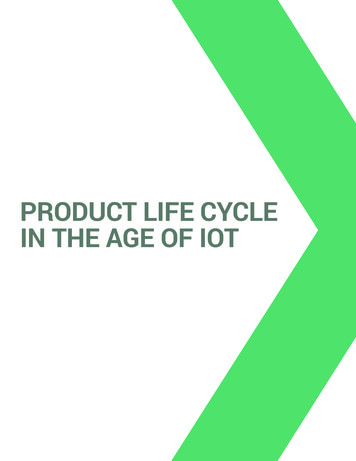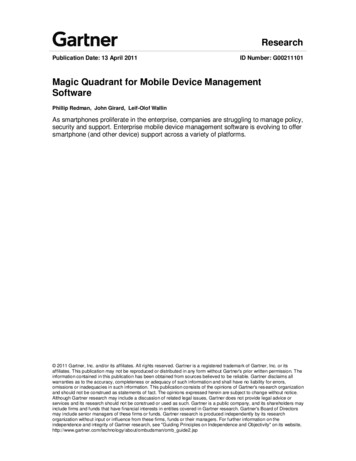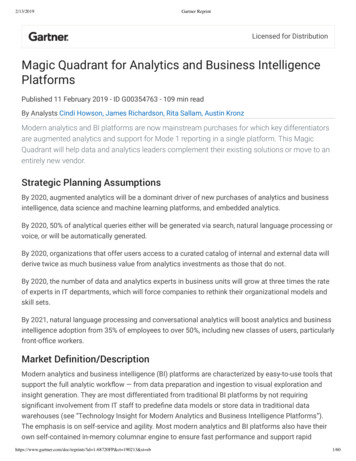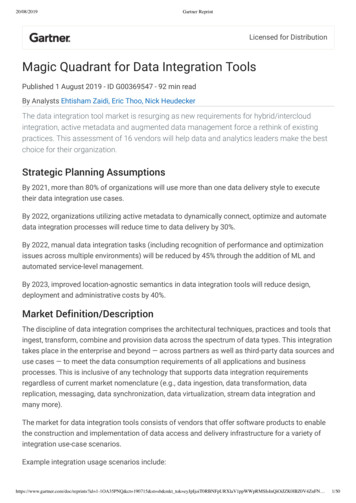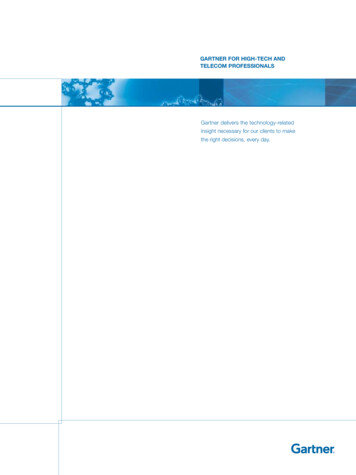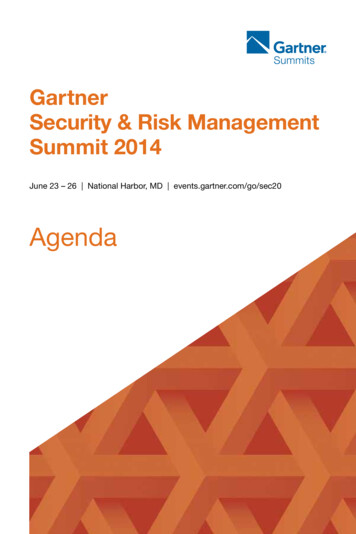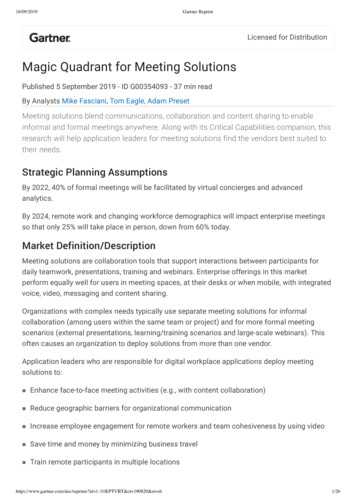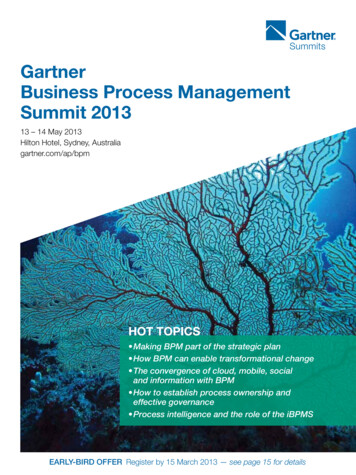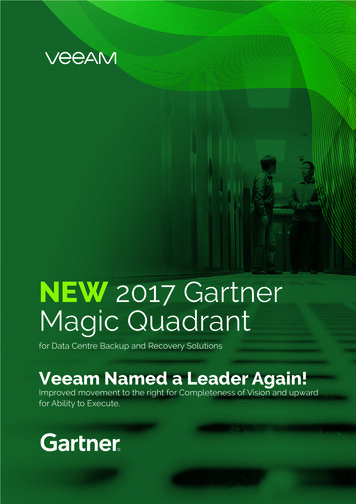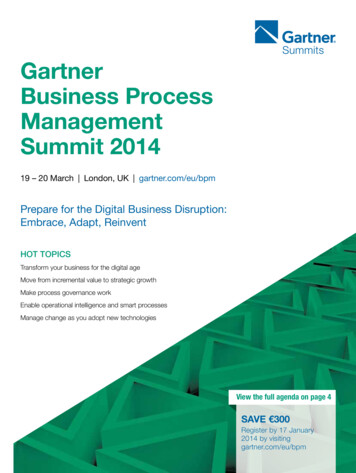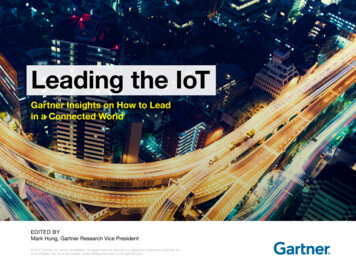
Transcription
Leading the IoTGartner Insights on How to Leadin a Connected WorldEDITED BYMark Hung, Gartner Research Vice President 2017 Gartner, Inc. and/or its affiliates. All rights reserved. Gartner is a registered trademark of Gartner, Inc.or its affiliates. For more information, email info@gartner.com or visit gartner.com.
IntroductionThe Internet of Things (IoT) has rapidly become one of themost familiar — and perhaps most hyped — expressionsacross business and technology.We expect to see 20 billion internet-connected things by2020. These “things” are not general-purpose devices, suchas smartphones and PCs, but dedicated-function objects,such as vending machines, jet engines, connected cars anda myriad of other examples.The IoT will have a great impact on the economy bytransforming many enterprises into digital businesses andfacilitating new business models, improving efficiencyand increasing employee and customer engagement.However, the ways in which enterprises can actualize anybenefits will be diverse and, in some cases, painful.Leading the IoTThe biggest barrier to the IoT is that most enterprises do notknow what to do with the technology. And if they do haveplans for the IoT, there is concern over who will be leadingthese initiatives. This need is an opportunity for CIOs to fillthat IoT leadership void.This book is intended to be a guide for CIOs and IT leaderswho want to take a broader view of the IoT; it provides themwith a foundation from which to start business conversations,develop their thinking and refine their approaches toaccelerate time to value from IoT initiatives.Mark HungGartner ResearchVice President2
ContentsCHAPTER 1CHAPTER 2CHAPTER 3CHAPTER 404121623Leverage the IoTSecure the IoTStaff the IoTExploit the IoTLeading the IoT3
CHAPTER 1Leverage the IoTLeading the IoT4
Leverage the IoTCommuters and pleasure travelers depend on reliable train service toget where they are going safely and with minimal delays. Train serviceoperators want to provide that reliable service while also optimizinginternal costs. Trenitalia, the main Italian service operator, leveraged theIoT in a three-year implementation plan to deliver improved reliabilityand compelling cost savings. With more than 1,500 train sets runningmore than 7,000 routes per day, Trenitalia shifted from corrective/reactive activities and maintenance plans to a system that reflects thereal conditions of each train’s components.Working together with its partner SAP, Trenitalia built a robust set of IoTuse cases, associated business benefits and financial models related tooptimizing train maintenance, and the team obtained buy-in from keyinternal stakeholders. These efforts resulted in a clearly defined threeyear implementation blueprint for the Dynamic Maintenance ManagementSystem (DMMS), which partners with Italian system integrator AlmavivAfor IT implementation and SAP for the data platform and analytics.DMMS leverages onboard and ground-based sensors and diagnosticsand sends that data to an on-premises private cloud for analytics innear real time. At the heart of DMMS is the transformation of maintenancefrom a mix of corrective/reactive activities and maintenance plans basedon distance and time, to a system based on life and health indicatorsthat reflect precisely the real physical conditions of each componentof the trains. Life indicators typically measure the expected wear ofcomponents by counting relevant parameters such as cycles, time,distance and energy. Health indicators measure the actual status ofcomponent operation, such as the closing time for a door or thetemperature of a cooling system.Leading the IoTThe Internet of Things (IoT) is a network of dedicatedphysical objects (things) that contain embeddedtechnology to communicate and sense or interact withtheir internal states or the external environment. Theconnecting of assets, processes and personnel enablesthe capture of data and events from which a companycan learn behavior and usage, react with preventiveaction, or augment or transform business processes.The IoT is a foundational capability for the creation ofa digital business.Brake pads, for example, had always been replaced according tostandard maintenance plans based on distance (kilometer) intervals.By adding a life indicator that measures the energy dissipationcapability of friction braking in real time, Trenitalia now knows thatroute-specific factors (hills, curves and local routes with many stops),along with kilometers, have a direct bearing on brake pad life.Combined with the addition of new health measures, such as brakepressure and temperature and whether the brake is on a locomotiveor a coach, Trenitalia has been able to optimize brake pad utilizationand reduce maintenance activities without impacting safety or reliability.5
Leverage the IoTAlthough Trenitalia is more than halfway through its three-yearimplementation plan, many other business and IT leaders are stillwondering if the IoT can ever overcome the hype and fulfill itspromise in organizational and societal disruption.“Initially, leaders viewed the IoT as a silver bullet, a technology that cansolve the myriad IT and business problems that their organizations faced.Very quickly, though, they recognized that without the proper framing ofthe problems, the IoT was essentially a solution looking for a problem,”says Mark Hung, research vice president and lead analyst for IoT research.“Next, leaders started to explore the applications and use cases forwhich the IoT is best suited as their organizations embarked on theirjourneys toward digitalization. Finally, in 2017, we expect some of these‘explorers’ to move to the ‘reality’ phase, when skunkworks projectsand proofs of concept graduate to commercial or production deployment.”As IoT projects become reality for some organizations, CIOs canleverage lessons from Trenitalia’s journey, aligning the IoT to desiredbusiness goals, gaining internal support for use cases and driving IoTinitiatives with a roadmap and blueprint to create significant value.Chart the path to IoT business valueThe generality of the term IoT and the wide variety of delivery forms andback-end services can make it difficult to identify how to capturebusiness value. Your first step is to move the conversation from talkingabout the IoT in general to talking about what it can do, or be, specificto your organization. The IoT can deliver business benefits ranging fromoperational improvements, such as predictive maintenance, to digitalbusiness transformation, such as selling product usage as a service.“ Initially, leaders viewed the IoT as a silver bullet, a technologythat can solve the myriad IT and business problems that theirorganizations faced. Very quickly, though, they recognizedthat without the proper framing of the problems, the IoT wasessentially a solution looking for a problem.”Mark Hung, Gartner Research Vice PresidentLeading the IoT6
Leverage the IoT“Do not be shortsighted. Start with a strategic perspective by aligninguse case identification with the strategic levers that drive successfor your organization. Be sure to balance pragmatism (what is provento deliver now) with vision (how the IoT can enable transformationalbusiness moments),” says Chet Geschickter, research director. “Movebeyond viewing the IoT as a general technology wave by applying anindustry lens to identify relevant use cases.”THE INTERNET OF THINGSEXTERNALBENEFITSImproveWell-BeingCreate a basic benefits frameworkThe benefits from the IoT can be internally focused, such as improvingyour employees’ safety in a hazardous production environment, orexternally oriented, such as improving patient outcomes in an acutecare setting. Build a basic benefits framework and organize benefits ata high level according to whether they are primarily internal or external.“ Move beyond viewing the IoTas a general technology waveby applying an industry lens toidentify relevant use agementImprove Safetyand esConserveResourcesChet Geschickter, Gartner Research DirectorLeading the IoT7
Leverage the IoT“Organizations should also look at the IoT in conjunction with othertechnologies,” says Geschickter. “What happens when the IoT iscombined with machine learning, advanced analytics, augmentedreality or all of the above? Look at broader bundles of technologiesand determine what can be done with those bundles. Combinatorialinnovation is a term we use for this. What creative solutions andofferings can you build when you mix multiple transformationaltechnologies together?”Ensure that every IoT project has clearlyidentified business goals and objectivesIt is essential before architecting and implementing any IoT solution thatsome time be spent to describe the IoT use case and value that yourIoT pilot or project will deliver to your enterprise. Leaders in Trenitalia’sengineering department — its CIO and other early project champions,for example — worked together with other functional leadership to gaininternal support, including obtaining funding for the initiative from thecompany’s CEO.This step is critical, as it describes what new functionality, capabilities ordifferentiation your IoT project will deliver. It links these to the impact oncustomers, validates what basic benefits you can expect and establishesthe metrics by which your IoT project’s success will be measured.Leading the IoTBe aware that certain use cases are more likely to create compellingfinancial payback than others. For example, Gartner has observed thatIoT use cases focused on delivering cost savings from fuel, energyand labor often have significant financial impact and shorter paybacktime frames. Also in this category are use cases within asset-intensivebusinesses or “heavy” industries. Here, industrial mechanical deviceswith high cost and complexity, critical asset value and remote geographiclocation realize IoT benefits such as remote asset monitoring andpredictive maintenance that maximize asset utilization and minimizecritical failure unplanned downtime.“ It is critical to reassess IoTprojects periodically duringimplementation to validate thatthe project will still deliver thebusiness goals, objectives,outcomes and business valueoriginally expected.”Nathan Nuttall, Gartner Research Director8
Leverage the IoT“We often see that IoT projects are challenging for enterprises and thatthey take some unexpected turns as they go through the architecture andimplementation process. This is due to a variety of reasons, includingunexpected complexity in solution design or integration, unanticipatedobstacles that need to be worked around, unforeseen performanceissues in the field and solutions with higher costs than planned,” saysNathan Nuttall, research director. “Most of these challenges aresolvable, but they can result in IoT implementations that stray from theoriginal plan. It is critical to reassess IoT projects periodically duringimplementation to validate that the project will still deliver the businessgoals, objectives, outcomes and business value originally expected.Otherwise, success of this IoT project and future projects in yourroadmap may be jeopardized.”Mapping out the best practices for getting an IoT initiative off theground, including upfront agreement and mapping of the IoT tobusiness objectives, development of use cases and creation of avision and roadmap, can help you stay on track to deliver on thestated business objectives as your IoT project progresses. (Seefigure below.)BUSINESS PROCESS MAP FOR IoT PROJECT INITIATIONIterate andValidateIdentifyBusinessGoalsIterate andValidateDevelopIoT UseCasesVerify IT andBU Are in SyncLeading the IoTCreate IoTVision andRoadmapGain InternalSupportLaunchIoT Pilotor POCUpdate IoTVision andRoadmapImplementInitiativeVerify InternalSupport9
Leverage the IoTBuild a blueprintGetting your IoT project off to a good start is essential to longterm success, but the IoT is not a “one size fits all” solution. Theintegration of IoT technologies varies significantly among companiesand industries. Implementing the right IoT solution requires an IoTarchitect, who must be able to employ “solution level” thinking.65%By 2020, more than65% of enterprises(up from 30% today)will adopt IoT products.Hung says enterprises will build and adapt their IoT implementationsto include a combination of five key architectural components — things,gateways, mobile devices, the cloud and the enterprise.Leading the IoT Things: Things can be dumb or smart on their own and storemost of their data on board. Things can also be self-sufficient andcommunicate to the internet for only centralized coordinationand analysis.Gateways: Gateways may house the application logic, store dataand communicate with the internet for the things that are connectedto it. Things don’t have to be as smart, because the gateway canprovide these resources.Mobile devices: Smartphones (or any mobile device) may house theapplication logic, store data and communicate with the internet onbehalf of things that are connected to it. Things don’t have to be assmart, because the mobile device provides these abilities.The cloud: The cloud can act as the central connection hub, poweranalytics and provision data storage. Things don’t have to be assmart, because the cloud will provide these resources.The enterprise: This architectural role is focused on keepingconnected machines, application logic, and analytics and datastorage on-premises — that is, behind the enterprise firewall.10
Leverage the IoT“When considering the IoT, we think of machines, vehicles, buildingsand consumer goods, all connected to the cloud,” says Hung. “Yet, willthis cloud approach be the predominant architecture for the IoT? Will weadd sensors and actuators to monitor and control things, and then relyon the cloud to provide computing resources and storage? Not always.”When a f
Leading the IoT. Leading T 2 The Internet of Things (IoT) has rapidly become one of the most familiar — and perhaps most hyped — expressions across business and technology. We expect to see 20 billion internet-connected things by 2020. These “things” are not general-purpose devices, such as smartphones and PCs, but dedicated-function objects, such as vending machines, jet engines .
